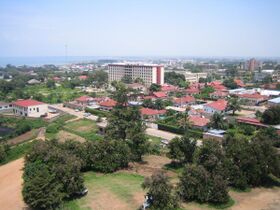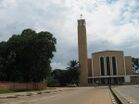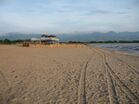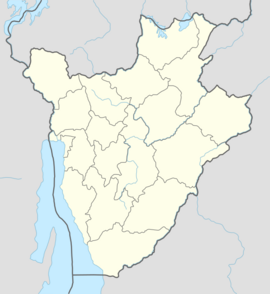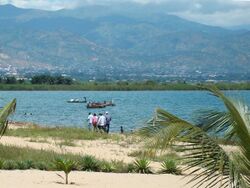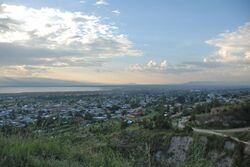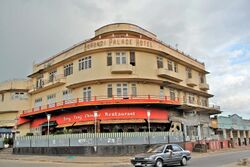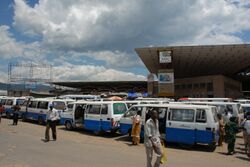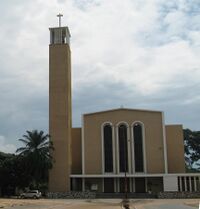Place:Bujumbura
Bujumbura | |
|---|---|
|
Top: Bujumbura skyline; Middle: Monument to Independence Heroes, Downtown Bujumbura; Regina Mundi Cathedral, Beach at Lake Tanganyika | |
| Nickname(s): | |
| Coordinates: [ ⚑ ] : 3°23′S 29°22′E / 3.383°S 29.367°E | |
| Country | |
| Province | Bujumbura Mairie Province |
| Founded | 1871 |
| Government | |
| • Mayor | CP Jimmy Hatungimana |
| Area | |
| • Urban | 127 km2 (49 sq mi) |
| Elevation | 774 m (2,539 ft) |
| Population (2023)[1] | |
| • City | 374,809 |
| • Urban | 1,143,202 |
| • Urban density | 9,000/km2 (23,000/sq mi) |
| Time zone | UTC+2 (CAT) |
| Climate | Aw |
| Website | www |
Bujumbura (fr; rw), formerly Usumbura, is the economic capital, largest city and main port of Burundi. It ships most of the country's chief export, coffee, as well as cotton and tin ore. Bujumbura was formerly the country's normal capital. In late December 2018, Burundian president Pierre Nkurunziza announced that he would follow through on a 2007 promise to return Gitega its former political capital status, with Bujumbura remaining as economical capital and center of commerce. A vote in the Parliament of Burundi made the change official on 16 January 2019, with all branches of government expected to move to Gitega within three years.[3]
History
Bujumbura grew from a small village after it became a military post in German East Africa in 1889. After World War I it was made the administrative center of the Belgian League of Nations mandate of Ruanda-Urundi. The name was changed from Usumbura to Bujumbura when Burundi became independent in 1962.[4] Since independence, Bujumbura has been the scene of frequent fighting between the country's two main ethnic groups, with Hutu militias opposing the Tutsi-dominated Burundi army.
Geography
Bujumbura is on the north-eastern shore of Lake Tanganyika, the second deepest lake in the world after Lake Baikal. The city also lies at the mouth of the Ruzizi River and two smaller rivers (Muha and Ntahangwa).
Climate
Bujumbura features a tropical savanna climate (Köppen: Aw)[5] bordering on a hot semi-arid climate (BSh). There are distinct wet and dry seasons. Its wet season is from October to April, while the dry season covers the remaining five months. Despite being located close to the equator, Bujumbura is not as hot as one might expect, due to its altitude. Average temperatures are constant throughout the course of the year with the high temperature at around 29 °C (84 °F) and the low temperature at around 19 °C (66 °F).
Script error: No such module "weather box".
Administration
thumb|A beach in Bujumbura on the north side of Lake Tanganyika Bujumbura is governed by a community council and community administrator. It is further divided into three communes, or neighborhoods, each with its own council and council leader.[8]
Each of the three current communes were created from the 13 former communes (currently sub-communes), due to a 2014 reorganization, which in turn are further sub-divided into villages or zones:[9]
- Commune of Muha
- Kanyosha
- Quarters: Gisyo-Nyabaranda, Gisyo, Musama I, Musama II, Musama III, Musama IV, Musama V, Nyabugete, Kizingwe-Bihara, Nkenga-Busoro, Ruziba, Kajiji
- Kinindo
- Quarters: Kibenga, Kinanira I, Kinanira II, Kinanira III, Kinanira IV, Kinindo, Zeimet-OUA
- Quarters: Gasekebuye-Gikoto, Gitaramuka, Kamesa, Kinanira I, Kinanira II
- Kanyosha
- Commune of Mukaza
- Buyenzi
- Quarters: I, II, III, IV, V, VI, VII
- Quarters: Bwiza I, Bwiza II, Bwiza III, Bwiza IV, Kwijabe I, Kwijabe II, Kwijabe III
- Quarters: Kigwati, Nyakabiga I, Nyakabiga II, Nyakabiga III
- Quarters: Centre Ville, Rohero I - Gatoke, Kabondo, Mutanga-Sud - Sororezo, Asiatique, I.N.S.S, Rohero II, Kiriri-Vugizo
- Buyenzi
- Commune of Ntahangwa
- Buterere
- Quarters: Buterere I, Buterere II A, Buterere II B, Kabusa, Kiyange, Maramvya, Mubone, Mugaruro, Kiyange
- Quarters: I, II, III, IV, V, VI, VII
- Gihosha
- Quarters: Gasenyi, Gihosha, Gikungu, Kigobe, Mutanga-Nord, Muyaga, Nyabagere, Taba, Winterekwa
- Quarters: Gikizi, Gituro, Heha, Kavumu, Mirango I, Mirango II, Songa, Teza, Twinyoni
- Kigobe
- Quarters: Kigobe Nord, Kigobe Sud
- Kinama
- Quarters: Bubanza, Buhinyuza, Bukirasazi I, Bukirasazi II, Bururi, Carama, Gitega, Kanga, Muramvya, Muyinga, Ngozi, Ruyigi, SOCARTI.
- Quarters: I, II, III, IV, V, VI, VII, VIII, IX, Industriel
- Buterere
Economy
Bujumbura's central market is in the City Centre, along Rwagasore Avenue. During the 1993 ethnic violence in Burundi, citizens had become less likely to travel far from the City Centre, and markets in neighbouring communities lost their business to the central market in Bujumbura. Consequently, vendors moved their business to the central market, many settling outside the market due to lack of space. However, the central market houses the largest variety of merchandise in the city, with stores that sell a wide range of goods.
At dawn of 27 January 2013 a serious fire ravaged Bujumbura's central market.[10] Due to poor emergency response, the fire lasted for hours, resulting in a serious blow to local exchanges. Hundreds of vendors, local and foreign, lost their goods to the fire and the reported looting.[11] While Burundi's emergency services were unable to extinguish the blaze on their own, neighbouring Rwanda sent helicopters to assist in the emergency response.[12]
Politics
List of mayors of Bujumbura
- Gérard Kibinakanwa, 1962–1967[13]
- Thérence Ndikumasabo, 1967–1969
- Pie Kanyoni, 1969–1975 and 1976–1977
- Charles Kabunyoma, 1976
- Juvénal Madirisha, 1977–1979
- Germain Nkwirikiye, 1979–1981
- Lucien Sakubu, 1981–1987
- Léonidas Ndoricimpa, 1987–1991
- Arthémon Mvuyekure, 1991–1992
- Anatole Kanyenkiko, 1992–1993
- Léonce Sinzinkayo, 1993–1994
- Pie Ntiyankundiye, 1994–2002
- Pontien Niyongabo, 2002–2005
- Célestin Sebutama, 2005–2007
- Elias Buregure, 2007
- Evrard Giswaswa, c. 2008–2012[14]
- Saidi Juma, c. 2012[15]
- Freddy Mbonimpa, 2017–2020
- Jimmy Hatungimana, 2020–
Sports
Bujumbura is the location for the city's multisport Intwari stadium. Mainly used for football games, it is the country's largest stadium with 22,000 seats.
The city is also home to multiple basketball and tennis courts, as well as a multitude of indoor and outdoor swimming pools.
Education
The University of Burundi is in Bujumbura, as are Hope Africa University, Université Paix et Réconciliation, Université des Grands Lacs, Université du Lac Tanganyika, Ecole Normale Supérieure, Université Lumière de Bujumbura, Bujumbura International University (BIU), International University of Equator, International Leadership University of Bujumbura, Université Ntare Rugamba of Bujumbura, Université Sagesse d'Afrique de Bujumbura, Université Martin Luther King, Institut Supérieur de Développement de Bujumbura (ISD), Ecole Nationale d'Administration "ENA", Institut National de Santé Publique "INSP", Institut Supérieur de Gestion des Entreprises "ISGE", Institut Supérieur d'Ingénieurs et Cadres Techniciens en Génie Informatique, Télécommunications et Technologies Avancées "INITELEMATIQUE".
International schools:
- École Belge de Bujumbura (Belgian school)
- École Française de Bujumbura (French school)
- King's School (British school)
- Bujumbura International Montessori School
- Burundi English School (English Language School)
- Cubahiro International School
Transport
The Bujumbura International Airport is situated on the outskirts of the city.
Public transport in Bujumbura mainly consists of taxis and mini-buses, locally known as the Hiace. Public transport vehicles are generally white and blue.
Bujumbura's taxis are abundant all over the city, and are considered the safest form of transportation. There are taxi-motos (motorcycle taxis) and taxis-vélos (bicycle taxis), although they are only available in certain parts of the city.
For long-distance travel, locals prefer to take the many Hiace full-size vans, which travel regularly across Burundi. Bujumbura's main bus terminal is located by the Central Market.
Health
Bujumbura is also home to many clinics and the province's main hospitals: the Prince Regent Charles Hospital, the Roi Khaled Hospital, and the Military Hospital.
Places of worship
Among the places of worship are predominantly Christian churches and temples: Roman Catholic Archdiocese of Bujumbura (Catholic Church), Province of the Anglican Church of Burundi (Anglican Communion), Union of Baptist Churches in Burundi (Baptist World Alliance), and Assemblies of God.[16] There are also Muslim mosques.
Culture
Bujumbura's main attractions are its many museums, parks and monuments. Museums in the city include the Burundi Museum of Life and the Burundi Geological Museum. Other nearby attractions are the Rusizi National Park, the Livingstone-Stanley Monument at Mugere (where David Livingstone and Henry Morton Stanley visited 14 days after their first historic meeting at Ujiji in Tanzania), the presidential palace and the source of the southernmost tributary of the Nile, described locally as the source of the Nile.
Bujumbura was also home of the independent weekly radio programme Imagine Burundi, the country's first locally produced English-language programme that focused on stories about life in the region. The show was broadcast from September 2010 to August 2013, and recordings are archived on the show's website at imagineburundi.com.[17]
Demographics
Bujumbura is projected to be the fourth fastest growing African continent city between 2020 and 2025, with a 5.75% growth.[18]
International relations
Bujumbura is twinned with:
 Ubon Ratchathani, Thailand
Ubon Ratchathani, Thailand Corigliano Calabro, Italy
Corigliano Calabro, Italy
References
- ↑ Chislennost.com Population of Bujumbura city
- ↑ PopulationStat Population of Bujumbura, city and urban area
- ↑ "Burundi to change its capital city". 18 January 2019. https://www.businessghana.com/site/news/politics/180180/Burundi-to-change-its-capital-city.
- ↑ Roman Adrian Cybriwsky, Capital Cities around the World: An Encyclopedia of Geography, History, and Culture, ABC-CLIO, USA, 2013, p. 72
- ↑ "Bujumbura - Climate graph, Temperature graph, Climate table". Climate-Data.org. http://en.climate-data.org/location/1073/.
- ↑ "World Weather Information Service - Bujumbura". World Meteorological Organization. http://worldweather.wmo.int/en/city.html?cityId=1519.
- ↑ "Klimatafel von Bujumbura (Usambara) / Burundi" (in de). Baseline climate means (1961-1990) from stations all over the world. Deutscher Wetterdienst. http://www.dwd.de/DWD/klima/beratung/ak/ak_643900_kt.pdf.
- ↑ L’administration de la Municipalité de Bujumbura, official city website
- ↑ https://www.refworld.org/docid/57f792e34.html Refworld | Burundi: List of all the neighbourhoods of Bujumbura, including the ethnicity and socio-economic status of the inhabitants of those neighbourhoods (2014-September 2016)
- ↑ Burundi: vaste incendie au marché central de Bujumbura Radio France internationale, 27 janvier 2013
- ↑ Incendie au marché central de Bujumbura: des Sénégalais dans la désolation Agoravox, 25 Février 2013
- ↑ Rwandan Helicopters Extinguish Fire in Bujumbura Market "IGIHE", 27 janvier, 2013
- ↑ "Succession à la tête de la Mairie de Bujumbura" (in fr). Villedebujumbura.org. Mairie de Bujumbura. http://www.villedebujumbura.org:80/spip.php?article48.
- ↑ "Burundi: le maire de Bujumbura absent à son procès" (in fr), Rfi.fr, 5 October 2011, http://www.rfi.fr/afrique/20111005-burundi-le-maire-bujumbura-absent-son-proces
- ↑ "Le sénat approuve 7 gouverneurs" (in fr), Isanganiro.org (Burundi), 25 October 2012, http://www.isanganiro.org/spip.php?article2956, retrieved 1 September 2017
- ↑ J. Gordon Melton, Martin Baumann, ‘‘Religions of the World: A Comprehensive Encyclopedia of Beliefs and Practices’’, ABC-CLIO, USA, 2010, p.456
- ↑ Imagine Burundi "Imagine Burundi", 1 juillet 2012
- ↑ "Ranked: The World's Fastest Growing Cities". virtual capitalist. 13 August 2021. https://www.visualcapitalist.com/ranked-the-worlds-fastest-growing-cities/.
Bibliography
External links
- Official Website of Bujumbura
- Map of Bujumbura
- Official Website of the Ministry of Justice of Burundi
- Lonely Planet guide
 |
